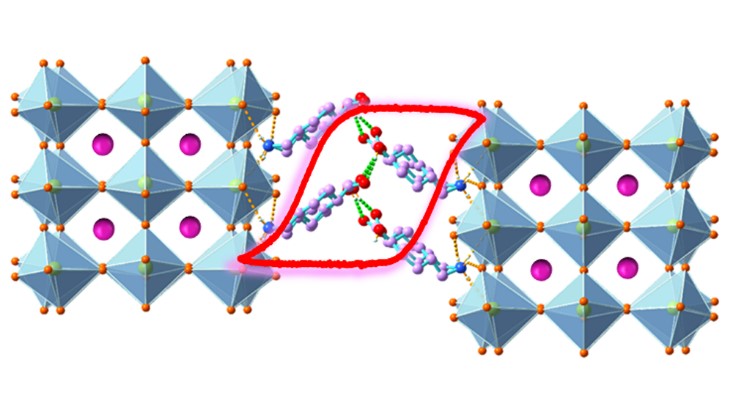
Two-dimensional (2D) hybrid perovskites of Ruddlesden-Popper (RP) lattices are recently booming as a vigorous class of ferroelectrics, whereas their intrinsic van der Waals gaps exert weak interactions that destabilize the layered motifs. Thus, it is a challenge to reduce interlayered energy gap for exploring stable RP ferroelectrics.
In a study published inJ. Am. Chem. Soc., the research group led by Prof. LUO Junhua and Prof. SUN Zhihua from Fujian Institute of Research on the Structure of Matter of the Chinese Academy of Sciences proposed hydrogen bonds to reduce van der Waals gaps of 2D RP-type perovskite phases while retaining ferroelectricity.
The researchers alloyed the homo-conformational trans-isomer for the first time as a cationic spacer to exploit a new molecular ferroelectric, (t-ACH)2(EA)2Pb3Br10 (t-ACH = 4-aminomethyl-1-cyclohexanecarboxylate, EA = ethylammonium).
They found that strong O-H···O hydrogen bonds link the adjacent organic layers to form a new quasi-RP motif with reduced energy gaps and enhanced phase stability. In terms of ferroelectricity, such directional O-H···O hydrogen bonds make a crucial role to the generation of polarization or formation of polar structure, as verified by structure analyses, quadratic optical nonlinearity and electric hysteresis loops.
Strong in-plane ferroelectricity with high Curie temperature (355 K) and spontaneous polarization (~2.9 μC/cm2) is well established for (t-ACH)2(EA)2Pb3Br10.
Furthermore, structure analyses revealed that the mixed-cation alloying makes a crucial role to its electric polarization, which means a breakthrough for reducing energy gaps of 2D RP lattice and retaining ferroelectricity.
Combining with the anisotropic nature of its 2D motif, such ferroelectricity creates strong linearly polarized-light sensitivity with a large dichroism ratio up to ~3.2.
This study showed the great potentials of (t-ACH)2(EA)2Pb3Br10 for practical device application. 2D RP-type ferroelectric with trans isomer cationic spacer is unprecedented, and the concept of reducing energy gaps via H-bonding interactions sheds light on rational design of stable ferroelectrics toward photoelectric applications.

Illustration of the Research (Image by Prof. LUO’s group)

86-10-68597521 (day)
86-10-68597289 (night)

52 Sanlihe Rd., Xicheng District,
Beijing, China (100864)

